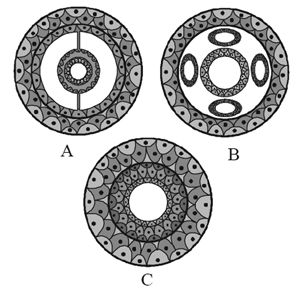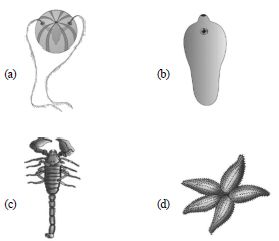Which of the following characteristic distinguish arthropoda from annelids and molluscs ?
An external skeleton made of chitin (a polysaccharide) and protein rather than a shell made chiefly of mineral salts.
Subdivision of the legs into movable segments.
Distinct group of muscles, derived from many body segments, that move the separate parts of the exoskeleton.
All of the above
Correct Answer :
D. All of the above
An arthropod has a segmented body covered by an exoskeleton made from chitin and other chemicals. This exoskeleton serves as protection and provides places for muscle attachment. Arthropods must moult because their exoskeletons don't grow with them. The body feature from which the phylum takes its name is the jointed appendages, which include antennae and mouthparts as well as walking legs.
Related Questions
Match the features given in column I with their examples given in column II and choose the correct match from the option given below.
| Column-I | Column-II |
|---|---|
| (Features) | (Examples) |
| A. Pseudocoelomates | a. Hydra, Adamsia |
| B. Diploblastic | b. Ctenoplana, Aurelia |
| C. Cellular level of | c. Ascaris, Wuchereria organization |
| D. Radial symmetry | d. Sycon, Spongilla |
| E. Metamerism | e. Pheretima, Neries |
A - e, B - b, C - d, D - c, E - a
A - c, B - a, C - d, D - b, E - e
A - b, B - a, C - c, D - e, E - d
A - c, B - b, C - d, D - a, E - e
Match the organisms given in column-I with their common name given in column-II and choose the correct option.
| Column -I | Column -II |
|---|---|
| (Organisms) | (Comman name) |
| A. Pennatula | I. Sea-lily |
| B. Antedon | II. Sea- pen |
| C. Echinus | III. Sea-urchin |
| D. Cucumaria | IV. Sea - cucumber |
A II; C III; D I; E IV
A II; C IV; D I; E III
A II; C I; D III; E IV
A II; C I; D III; E IV
Identify the figures and select the correct option

A - Pseudocoelomate; B - Coelomate, C-Acoelomate
A - Coelomate, B - Pseudocoelomate, C- Acoelomate
A - Coelomate; B- Acoelomate; C - Pseudocoelomate
A - Coelomate; B- Acoelomate; C-Eucoelomate
Which of the following statements is without exception in sponges ?
They all have calcareous spicules.
They have high regenerative power.
They are found only in marine water.
They are all radially symmetrical.
The figure given below is the characteristic structure of the phylum in which animals are aquatic, free swimming or sessile, mostly marine, radially symmetrical. Identify the phylum and correct function of the structure.

Ctenophora; Emission of light.
Porifera; Feeding, respiration and excretion.
Cnidarian; Anchorage, Defense and food capturing
Mollusca; Locomotion, transport of food and respiration.
Which of the following characteristic distinguish arthropoda from annelids and molluscs ?
An external skeleton made of chitin (a polysaccharide) and protein rather than a shell made chiefly of mineral salts.
Subdivision of the legs into movable segments.
Distinct group of muscles, derived from many body segments, that move the separate parts of the exoskeleton.
All of the above
Which of the following phylum is being described by the given statements?
(i) These are primitive multicellular animals and have cellular level of organization.
(ii) Digestion is intracellular.
(iii) They have a water transport or canal system.
(iv) They reproduce asexually by fragmentation and sexually by formation of gametes.
Porifera
Ctenophora
Coelenterata
Platyhelminthes
A student brought home a strange animal which he found outside under a rock. It had moist skin, a complete digestive tract, a ventral nerve cord, and had gone through torsion. Identify the phylum of the animal.
Porifera
Annelida
Mollusca
Echinodermata
Aquatic annelids (like Nereis) possess lateral appendages called ______________, which help in swimming.
visceral hump
parapodia
radula
spicules
Which one of the following features is common in silverfish, scorpion, dragonfly and prawn?
Three pairs of legs and segmented body.
Chitinous cuticle and two pairs of antennae.
Jointed appendages and chitinous exoskeleton.
Cephalothorax and tracheae.
In amphibians, respiration occurs through
gills
lungs
skin
all of these
Which of the following is a living fossil?
Balanoglossus
Echinus
Ancylostoma
Limulus
Select the incorrect feature of mollusca from the given statements.
- Terrestrial or aquatic animals having cellular system level of organization.
- Radial symmetrical and acoelomate animals and possesses two germinal layers.
- A file like rasping organ called radula is present.
- Usually dioecious and viviparous animals.
- Examples include Pila, Octopus, and Dentalium.
(i) and (ii) only
(ii) and (iv) only
(i), (ii) and (iv) only
All the five statements.
Refer the following animals and identify those which have a fluid filled body cavity with a complete lining derived from mesoderm.
(i) Sycon (ii) Butterfly
(iii) Nereis (iv) Sea fan
(v) Scorpion (vi) Pila
(i) and (iii) only
(ii) and (iv) only
(ii), (iii), (v) and (vi) only
All of these
In ctenophora, the body bears _______ external rows of ciliated comb plates, which help in locomotion.
five
six
seven
eight
Which of the following possesses poison sting and belongs to class chondrichthyes?
Labeo
Myxine
Clarias
Trygon
Which one of the following groups of animals is correctly matched with its characteristic feature without even a single exception ?
Reptilia : possess 3 - chambered heart with one incompletely divided ventricle.
Chordata : Possess a mouth provided with an upper and lower jaw.
Chondrichthyes : Possess cartilaginous endoskeleton.
Mammalia : Give birth to young one.
Which of the following is not a characteristic of phylum echinodermata ?
They have a water vascular system.
They have an internal skeleton.
They are protostomes.
They have bilateral symmetry at larval stage.
Which of the following traits is not shared by both sea anemones and jellyfish ?
A medusa as the dominant stage in the life cycle.
Possession of a gastro vascular cavity.
Sexual reproduction.
Nematocysts present on the tentacles.
Which of the following animal contains respiratory organs like, gills, book gills, book lungs or tracheal system?

Click to check answer
Click to check answer
Click to check answer
Click to check answer
Which of the following group of animals belongs to the same phylum?
Earthworm, pinworm, tapeworm
Prawn, scorpion, Locusta
Sponge, Sea anemone, starfish
Malarial parasite, Amoeba, mosquito
Which of the following group of animals reproduces only by sexual means?
Ctenophora
Cnidaria
Porifera
Protozoa
Flame cells present in platyhelminthes, are specialized in
respiration and absorption.
osmoregulation and circulation.
respiration and excretion.
osmoregulation and excretion.
The combination of a true coelom and repeating body segmentation allows the annelids (unlike the anatomically simpler worms) to do which of the following?
Attain complex body shapes and thus locomote more precisely.
Move through loose marine sediments.
Be hermaphroditic.
Inject paralytic poisons into their prey.
Hemichordates have now been placed with the nonchordates, close to echinoderms, because true
notochord is absent.
pharyngeal gill-slits are lacking.
dorsal nerve cord is absent.
heart is lacking.
Column I contains zoological names of animals and column II contains their common name. Match the following and choose the correct option.
| Column -I | Column- II |
|---|---|
| A. Physalia | I. Sea anemone |
| B. Meandrina | II. Brain coral |
| C. Gorgonia | III. Sea fan |
| D. Adamsia | IV. Portuguese man-of-war |
A III; B II; C I; D IV
A IV; B III; C II; D I
A IV; B II; C III; D I
A II; B III; C I; D IV
In which of the phylum, excretory organ like proboscis gland is present?
Hemichordata
Chordata
Echinodermata
Annelida
A file like rasping organ for feeding, called radula, present in the phylum __________.
arthropoda
mollusca
echinodermata
chordata
Which of the following statement(s) is/are correct regarding phylum mollusca?
They are bilaterally symmetrical, triploblastic and coelomate animals.
Body is covered by a calcareous shell and is unsegmented with a distinct head, muscular foot and visceral hump.
The mouth contains a file-like rasping organ for feeding, called radula.
All of the above
Match the phylum given in column - I with their example given in column - II and choose the correct option.
| Column -I | Column- II |
|---|---|
| (Phylum) | (Examples) |
| A. Echinodermata | I. Ascidia, Doliolum |
| B. Hemichordata | II. Asterias, Ophiura |
| C. Urochordata | III. Branchiostoma |
| D. Cephalochordata | IV. Balanoglossus, Saccoglossus |
A IV; B II; C I; D III
A II; B IV; C I; D III
A II; B IV; C III; D I
A II; B I; C IV; D III
